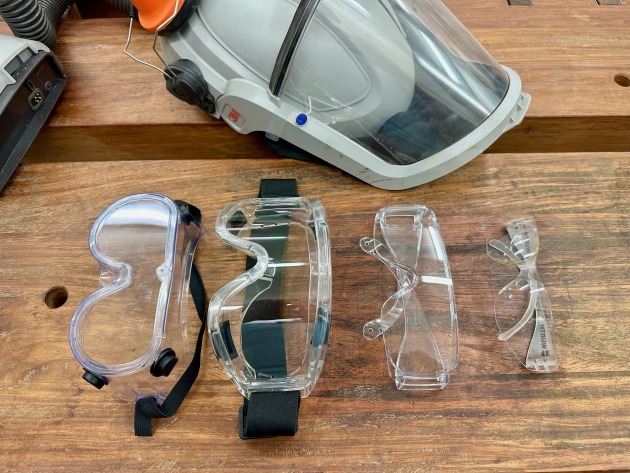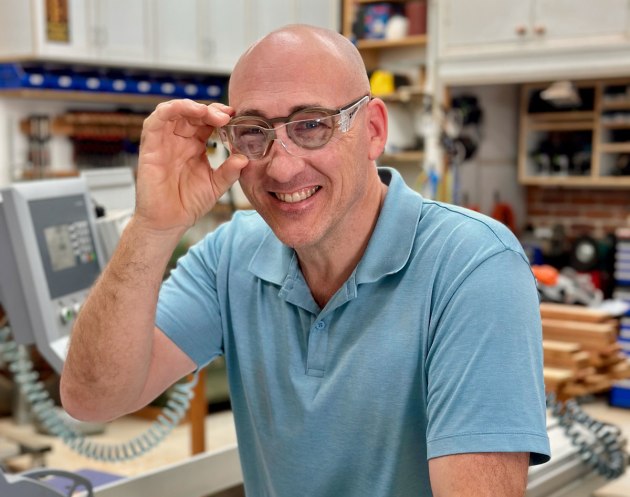PPE: High-impact eye protection
Above: 3M’s Versaflo helmet is the ultimate protection for eyes, ears and lungs. It is long-lasting and effective but expensive. Square safety goggles accommodate prescription glasses but are generally less comfortable than the wrap around kind (left and centre left). Safety glasses generally offer less protection, although the larger, more enclosed type (centre right) are better than their smaller counterparts (right).
Words and photos: David Luckensmeyer
Have you ever taken a trip to the Emergency Department with something in your eye? Well I have and it is not fun. Actually, it was downright scary to have foreign material lodged in one eye, with the eye scratched, red and swollen, while waiting for my turn with the doctor.
There was no long-term harm in my case, but it could have been very different. Let this article serve as a reminder for all of us to wear proper eye protection. Below, I share simple truths about workshop dangers and work through some solutions.
Australian Standards
Australian Standard 1336 (AS 1336) lists eye protection devices including safety glasses, goggles, face shields, hoods and helmets, while AS 1337 lists the hazards encountered during various work processes like (among others): flying particles and fragments, dusts, splashing materials and molten metals, harmful gases, vapours and aerosols.
The Standards also refer to low-, medium-, high- and very high- impact resistance levels. Offcuts and fragments coming off the tablesaw, for example, are classed as high-impact (between 45–120m/s).

Above: If you wear prescription glasses like me, look for square/flat safety goggles to suit.
Common workshop dangers
Woodworking is dangerous to lungs, eyes, ears and fingers (and bank accounts). The moment we walk into our shops we need to put on personal protective equipment (PPE), including eye protection.
The bench grinder often sends out a stream of sparks. Nail guns can misfire unpredictably. Routers, angle grinders and powercarvers produce significant amounts of flying debris. Woodturners know what I mean: a stream of chips from a bowl gouge can make it hard to breathe let alone see!
These dangers are mostly from flying debris like dust, chips, metal bits, or even bigger splinters and chunks catching the back of a blade. But don’t forget as makers we might also handle thinners or reducers when applying a finish. A splash of the wrong liquid can be very dangerous to our vision.
High-impact speeds
During my research, I was shocked by the cutter speeds of machinery in my shop. I’m including the formula so you can match the potential impact speeds with the right PPE in your situation.
To calculate speed, you only need the cutter diameter in mm (D), and the speed of the machine (rpm): speed (m/s) = π x D x rpm/60,000. For my tablesaw with a blade of 300mm running at 4,500rpm, the cutter speed is just over 70m/s. That’s around 250km/hr! Very fast in other words.
Eye protection options
Ordinary prescription glasses are not good enough. Lenses can break or pop out and frames can break, and there is no protection from the sides. While I routinely stand to the side of the blade when using the tablesaw, my eyes deserve better protection and so do yours.
Safety glasses are definitely better but not by much. At least make sure the impact rating is appropriate for the work being performed. Otherwise, safety glasses often do not protect from the sides (nor from excessive airborne dust). Just so you know: I was wearing safety glasses before I took that trip to the hospital. I should have been wearing goggles.
Safety goggles is the first category to offer the potential for high-impact eye protection. Goggles usually have a higher rating, and most importantly, keep out flying debris from all sides.
Finally, depending on what we’re doing, a face shield may be the most suitable eye protection solution. The best shields offer integrated dust and ear protection options as well.
No excuses
Virtually all of the options mentioned above are available at multiple stores and online for $5–$15, so eye protection is not expensive. None of us has any excuse that washes. The more I look at personal protections (whether ears or eyes), the more convinced I am that dedicated safety equipment is a must.
David Luckensmeyer @luckensmeyer is a Brisbane-based woodworker and furniture maker, see www.luckensmeyer.com.au




